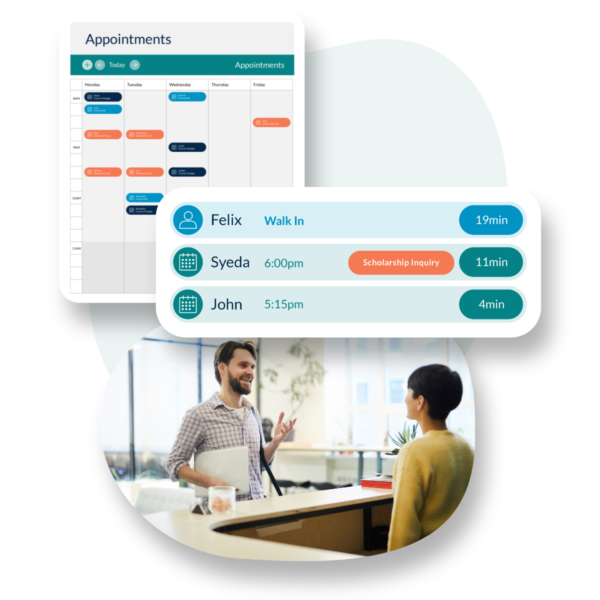Turning no-show appointments into efficiency wins
- Organizations often turn to reminders, overbooking, and data analysis to tackle the challenge of no-show appointments
- WaitWell allows the integration of appointments and walk-ins to address the no-show problem. The system helps eliminate the typical chaos of walk-ins, enabling resource efficiency, customer satisfaction, and reduced operational costs
Countless organizations have cancelled walk-ins and moved to appointment-only systems to manage crowds and workloads better. Some have done this more recently as a response to pandemic restrictions. However, the downside of this strategy is that high rates of no-show appointments create inefficiencies for them.
No-show appointments present a persistent financial and logistical challenge for many organizations. Potential monthly costs can go as high as hundreds of thousands of dollars. WaitWell has found that some service locations can record as high as 40% no-show rates daily. According to Medbridge Transport, patients who don’t keep their appointments cost the healthcare industry $150 billion annually in the US. And on average, no-shows cost a single-physician medical practice $150,000 annually.
People failing to show up for their scheduled appointments is so widespread that most industries have one version of the problem or the other. It’s a recurring headache for service managers, business owners and administrators across diverse sectors, from public service to healthcare and higher education.
How to deal with no-show appointments:
While most customers do not set out to be no-shows, several factors contribute to missed appointments. From forgetfulness to scheduling conflicts, illnesses, transportation issues, and even fear or anxiety. Understanding this variety of reasons is vital for service locations. It provides context to address the situation of missed appointments effectively.
Some common strategies organizations use to reduce or mitigate the effects of no-shows include:
Appointment reminders and notifications: Businesses that use appointment reminders and notifications often report lower rates of missed appointments. Whether these come as emails, text messages, or phone calls, the key is to remind clients of their upcoming appointments well in advance.
By sending a friendly reminder a day or two before the appointment, clients get ample time to reschedule or cancel if necessary. A follow-up reminder a few hours before the appointment is standard practice for many busy service locations. These reminders often reduce the chances of no-shows and show commitment to delivering excellent service.
Overbooking and waitlist management: Another common strategy is an overbooking and waitlist management approach. This tactic works particularly well for organizations that experience a high volume of appointments. Overbooking means scheduling more appointments than a location can handle, assuming some customers will not show up. However, this is a balancing act: overbooking without proper management can compromise service quality and put undue pressure on service staff.
Waitlist management complements overbooking. When a client cancels or reschedules an appointment, these slots can be immediately filled with someone from the waitlist. This way, schedules remain full, and the impact of no-shows is reduced.
Data analysis and predictive modelling: In today’s data-driven world, organizations can leverage data analysis and predictive modelling to deal with no-show appointments more efficiently. By analyzing historical appointment data, patterns and trends may show up that can help predict no-shows. For example, a veterinary clinic might discover that appointments scheduled during certain times of the day are more likely to result in no-shows.
With this information, scheduling practices can be adjusted to minimize the chances or effects of no-shows. Predictive modelling also helps identify clients more prone to no-shows based on past behaviour. Thus, it enables proactive planning for potential no-shows.
No-shows are inevitable: How can businesses maintain maximum efficiency despite missed appointments?
No-shows can be turned into efficiency wins. While reminders, waitlists, overbooking, and predictive modelling are effective tactics for reducing and managing no-shows, complete elimination remains nearly impossible for most businesses. Consequently, organizations still grapple with reduced revenue, wasted resources, and longer wait times for other clients.
Walk-ins are a viable option to fill the open slots left by missed appointments. However, incorporating walk-ins can be challenging, leading to staff pressure, overcrowded waiting rooms, and inefficient resource allocation – as most organizations have learnt from experience.
What if businesses could seamlessly integrate appointments and walk-ins, achieving efficient resource allocation? What if they can do this while ensuring an exceptional experience for staff and customers?
This is precisely what WaitWell offers: a fully customizable solution that allows organizations to create their ideal customer workflow for every service location. Every customer arrives at the right place at just the right time and is fully prepared for service. WaitWell comes equipped with multiple customer experience-driven features, such as automated notifications and a robust insights dashboard.

Advantages of managing walk-ins and appointments in one system
Improving resource allocation
WaitWell’s innovative queue management system incorporates appointment scheduling to optimize service experience. By seamlessly integrating no-show appointments and walk-ins, the system ensures that open slots caused by missed appointments are quickly filled and monitored on the same dashboard, minimizing downtime and maximizing resource utilization. Staff can stay engaged and productive while equipment and facilities are consistently used. This translates into increased efficiency and revenue as organizations maximize every available resource.
Enhancing customer experience
Customer flow features on the WaitWell system are designed to provide a superior experience for clients, guests, or patients. When no-shows are effectively converted into filled appointments, waiting times are reduced. Clients, whether appointments or walk-ins, no longer have to endure frustrating delays, leading to increased satisfaction and loyalty. WaitWell also offers the flexibility for customers to book or modify appointments, view real-time wait times and updates, and receive personalized reminders. The hassle-free and convenient experience makes clients happy and encourages them to provide glowing reviews.
Reducing operational costs
No-shows can significantly drain operational costs, from underutilized staff to wasted resources and utilities. WaitWell’s solutions help minimize these costs by ensuring resources are consistently in use rather than sitting idle due to missed appointments. WaitWell’s analytics dashboard also provides insights for fine-tuning scheduling and resource allocation to ensure operational efficiency. This, in turn, reduces unnecessary expenses and contributes to a healthier bottom line.
Walk-ins are especially useful in filling the gaps left by no-show appointments. With WaitWell offering the opportunity to integrate walk-in queue management with appointment scheduling, it is a win on all fronts. Organizations can get the best of walk-ins and appointments while boosting customer satisfaction, staff experience and the bottom line.







